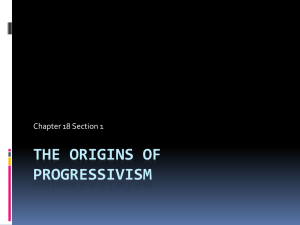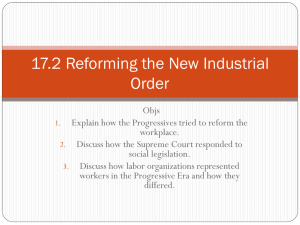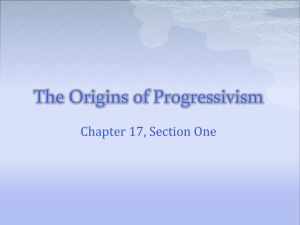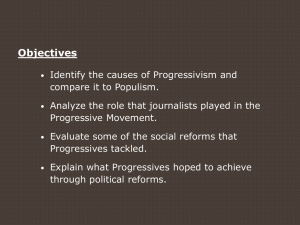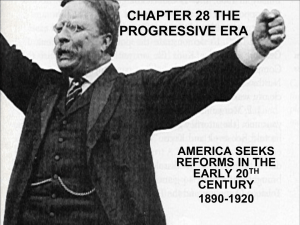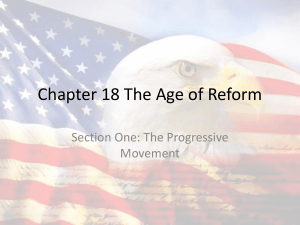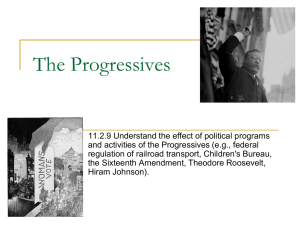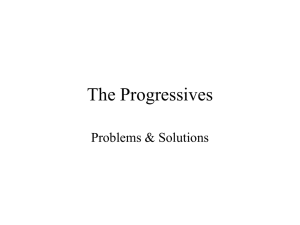Overview of the Progressive Era
advertisement
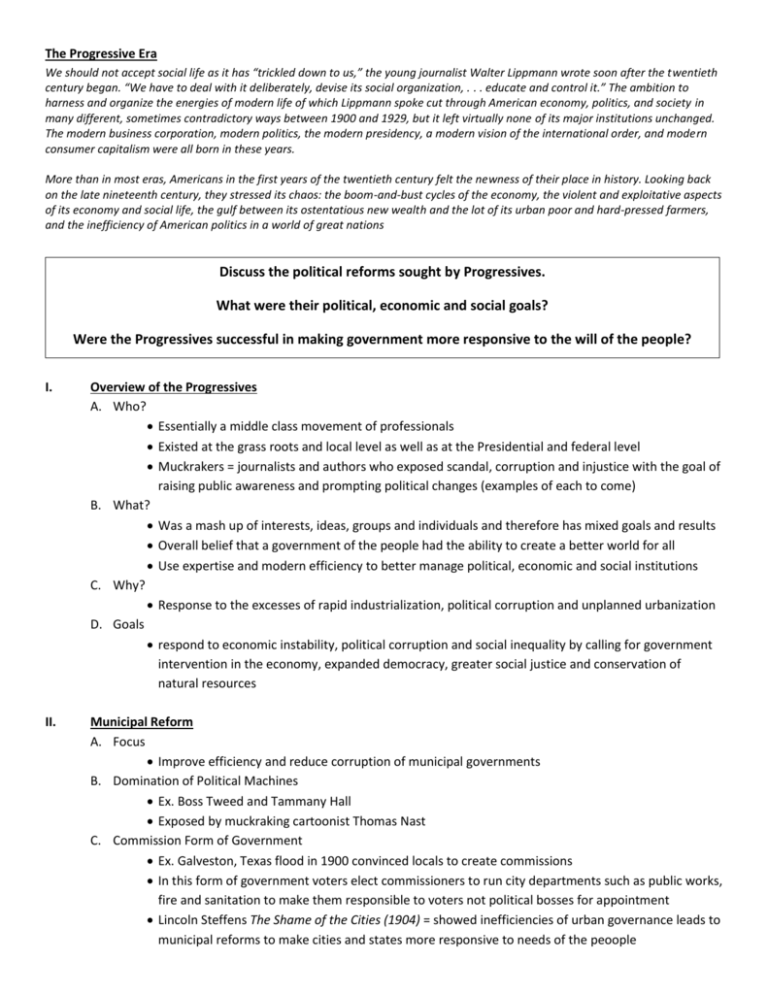
The Progressive Era We should not accept social life as it has “trickled down to us,” the young journalist Walter Lippmann wrote soon after the twentieth century began. “We have to deal with it deliberately, devise its social organization, . . . educate and control it.” The ambition to harness and organize the energies of modern life of which Lippmann spoke cut through American economy, politics, and society in many different, sometimes contradictory ways between 1900 and 1929, but it left virtually none of its major institutions unchanged. The modern business corporation, modern politics, the modern presidency, a modern vision of the international order, and modern consumer capitalism were all born in these years. More than in most eras, Americans in the first years of the twentieth century felt the newness of their place in history. Looking back on the late nineteenth century, they stressed its chaos: the boom-and-bust cycles of the economy, the violent and exploitative aspects of its economy and social life, the gulf between its ostentatious new wealth and the lot of its urban poor and hard-pressed farmers, and the inefficiency of American politics in a world of great nations Discuss the political reforms sought by Progressives. What were their political, economic and social goals? Were the Progressives successful in making government more responsive to the will of the people? I. Overview of the Progressives A. Who? Essentially a middle class movement of professionals Existed at the grass roots and local level as well as at the Presidential and federal level Muckrakers = journalists and authors who exposed scandal, corruption and injustice with the goal of raising public awareness and prompting political changes (examples of each to come) B. What? Was a mash up of interests, ideas, groups and individuals and therefore has mixed goals and results Overall belief that a government of the people had the ability to create a better world for all Use expertise and modern efficiency to better manage political, economic and social institutions C. Why? Response to the excesses of rapid industrialization, political corruption and unplanned urbanization D. Goals respond to economic instability, political corruption and social inequality by calling for government intervention in the economy, expanded democracy, greater social justice and conservation of natural resources II. Municipal Reform A. Focus Improve efficiency and reduce corruption of municipal governments B. Domination of Political Machines Ex. Boss Tweed and Tammany Hall Exposed by muckraking cartoonist Thomas Nast C. Commission Form of Government Ex. Galveston, Texas flood in 1900 convinced locals to create commissions In this form of government voters elect commissioners to run city departments such as public works, fire and sanitation to make them responsible to voters not political bosses for appointment Lincoln Steffens The Shame of the Cities (1904) = showed inefficiencies of urban governance leads to municipal reforms to make cities and states more responsive to needs of the peoople D. Civil Service Reform Back to Gilded Age politics following the assassination of Pres. Garfield Pendleton Act of 1883 set up merit based government jobs so that qualified individuals rather than friends of politicians received appointments III. Democratization of America A. Focus Make local, state and national government more response to the popular will B. Expansion of Democracy Referendum = allowed people to vote directly on proposed legislation (like our state propositions) Recall = empowered people to remove elected officials before term ended (2003, Californians removed Gov. Gray Davis and replaced with Arnold) Initiative = allowed citizens to introduce a bill to local or state legislation by petition Direct Primaries = took selection of candidates out of hands of political machines and gave members of the party the ability to vote for their candidates (Wisconsin the first to do so in 1903, most states had them by 1916) Leadership of Robert M. La Follette in Wisconsin was integral to the Progressive reform movement th C. 17 Amendment Called for direct election of Senators who had been previously selected by state legislatures IV. Progressives and Capitalism A. Focus Reduce the harmful effects that unregulated business had on economic and social activities B. Ida Tarbell History of the Standard Oil Company (1904) exposed Rockefellers tactics and eventually led to the government breaking up Standard Oil in 1911 C. Upton Sinclair The Jungle(1906) leads directly to the passage of the Meat Inspection Act and the Pure Food and Drug Act D. Triangle Shirtwaist Factory Fire (1911) Deaths of 146 workers (most young immigrant women) led to the creation of fire safety and support for workers’ rights V. Progressives and the Poor A. Focus Sought to improve the lives of nation’s poorest residents B. Jane Addams and the Settlement House Movement Hull House in Chicago By 1911 over 400 settlement houses in the U.S. C. Jacob Riis How the Other Half Lives (1890) calls on the wealthy to help aid the poor to reduce the impacts of extreme poverty on society VI. Moral Reform A. Focus Attack the social ills and impose notions of proper behavior on society, attempts in many cases to hold on to traditional values in a increasingly modern and changing society B. Campaign against Prostitution Collection of religious views, gender equality and double standards, public health and poverty pressured authorities Mann Act (1910) which cracked down on transport of women across state lines C. Temperance Movement Movement to ban alcohol Anti-Saloon League (1895) Women’s Christian Temperance Union (1874) More to come on this with the eventual passage of the 18th Amendment in 1920 D. Woman’s Suffrage National American Woman Suffrage Association (NAWSA) led by Carrie Chapman Catt took a moderate position using letter writing National Women’s Party (NWP) led by Alice Paul held spirited meetings, rallys, protests, marches and other demonstrations Does eventually lead to the ratification of the 19th Amendment in 1920 VII. Progressives in the White House A. Focus Although primarily a grass roots movement, by the early 20 century both Republicans and Democrats picked up various pieces of the progressive cause B. Theodore Roosevelt (1901-1909) Republican (later Bull Moose Party) Square Deal focused on 3 C’s Control of Corporations 1. Used “bully pulpit” to arbitrate or act as judge in labor disputes 2. Strengthened Interstate Commerce Act with passage of the Elkins Act which targeted railroad practices of granting rebates and the Hepburn Act with gave the ICC power to set rates 3. Trust Buster – a bit misleading as Roosevelt determined “good and bad trusts” 4. Northern Securities Co. vs. United States (19040) upheld his decision to break up the railroad monopoly Consumer Protection 1. In wake of Sinclair’s The Jungle he did pass the Meat Inspection Act and the Pure Food and Drug Act Conservation 1. Worried that mining and logging operations were destroying the environment TR set out to protect areas of the country and expanded the National Parks system C. William Howard Taft (1909-1913) Republican TR’s hand selected successor Actually pursued more antitrust suits than TR, with a total of 90 including the breakup of U.S. Steel D. Woodrow Wilson (1913-1921) Democrat Federal Reserve Act (1913) = created the Federal Reserve Bank (The FED) to regulate economic growth through control of the money supply and interest rates Clayton Antitrust Act (1914) – strengthened the Sherman Antitrust Act by specifically exempting unions giving them more power to strike and negotiate with business VIII. Failure or Success? A. Success Generated great publicity to the variety of issues in American society Beginnings of government regulation over the economy (still debate to what extent today) Better consumer protection Progressive spirit did result in several new Amendments Urban problems addressed by social work and charity but at the time little done with federal government Political improvements of local and state governments Birth of Conservation Movement (Go Green) B. Failures Did not address racial issues, still largely ignored in the wake of Reconstruction Child Labor remained Some historians argue that progressivism did not pose a serious challenge to business Another argument is that this was the will of the upper and middle class being imposed on the poor and gorwing immigrant class, an attempt to hold on to traditional values at the time when the country’s demographics were greatly changing C. Future Impact The modern battle between unbridled capitalism and an active democracy truly begins here in the Progressive Era Impact will be seen in the progressive influences on the New Deal of the 1930s Also influences the 20th century views of liberalism The Progressive Era We should not accept social life as it has “trickled down to us,” the young journalist Walter Lippmann wrote soon after the twentieth century began. “We have to deal with it deliberately, devise its social organization, . . . educate and control it.” The ambition to harness and organize the energies of modern life of which Lippmann spoke cut through American economy, politics, and society in many different, sometimes contradictory ways between 1900 and 1929, but it left virtually none of its major institutions unchanged. The modern business corporation, modern politics, the modern presidency, a modern vision of the international order, and modern consumer capitalism were all born in these years. More than in most eras, Americans in the first years of the twentieth century felt the newness of their place in history. Looking back on the late nineteenth century, they stressed its chaos: the boom-and-bust cycles of the economy, the violent and exploitative aspects of its economy and social life, the gulf between its ostentatious new wealth and the lot of its urban poor and hard-pressed farmers, and the inefficiency of American politics in a world of great nations Discuss the political reforms sought by Progressives. What were their political, economic and social goals? Were the Progressives successful in making government more responsive to the will of the people? I. Overview of the Progressives A. Who? B. What? C. Why? D. Goals II. Municipal Reform A. Focus B. Domination of Political Machines Ex. Boss Tweed and Tammany Hall Thomas Nast C. Commission Form of Government Ex. Galveston, Texas flood in 1900 Lincoln Steffens The Shame of the Cities (1904) = D. Civil Service Reform Pendleton Act of 1883 III. Democratization of America A. Focus B. Expansion of Democracy Referendum = Recall = Initiative = Direct Primaries = th C. 17 Amendment IV. Progressives and Capitalism A. Focus B. Ida Tarbell History of the Standard Oil Company (1904) C. Upton Sinclair The Jungle(1906) D. Triangle Shirtwaist Factory Fire (1911) V. Progressives and the Poor A. Focus B. Jane Addams and the Settlement House Movement C. Jacob Riis How the Other Half Lives (1890) VI. Moral Reform A. Focus B. Campaign against Prostitution Mann Act (1910) C. Temperance Movement Anti-Saloon League (1895) Women’s Christian Temperance Union (1874) 18th Amendment (1920) D. Woman’s Suffrage National American Woman Suffrage Association (NAWSA) National Women’s Party (NWP) 19th Amendment (1920) VII. Progressives in the White House A. Focus B. Theodore Roosevelt (1901-1909) Republican (later Bull Moose Party) Square Deal focused on 3 C’s Control of Corporations 1. Elkins Act which and the Hepburn Act 2. Northern Securities Co. vs. United States (1904) Consumer Protection Conservation C. William Howard Taft (1909-1913) Republican D. Woodrow Wilson (1913-1921) Democrat Federal Reserve Act (1913) = Clayton Antitrust Act (1914) = VIII. Failure or Success? A. Success B. Failures C. Future Impact
